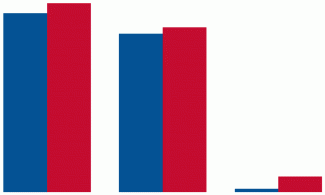Released August 13, 2019
 The numbers are in. And there is a lot to talk about! With virtually 100% of the final applicant count now available, how do applicant volumes and applications fare compared to last year? What about the total number of LSATs administered for 2018-2019 versus 2017-2018? Join LSAC’s Susan Krinsky as she highlights the latest data, including final test taker numbers for June and a noteworthy insight from July. Also learn about some new enhancements to the ACES² Statistical History Dashboard, based on your requests.
The numbers are in. And there is a lot to talk about! With virtually 100% of the final applicant count now available, how do applicant volumes and applications fare compared to last year? What about the total number of LSATs administered for 2018-2019 versus 2017-2018? Join LSAC’s Susan Krinsky as she highlights the latest data, including final test taker numbers for June and a noteworthy insight from July. Also learn about some new enhancements to the ACES² Statistical History Dashboard, based on your requests.
UPDATE: The projected score release date for July 2019 LSAT scores is now August 21 instead of August 28. Test takers will have until September 4, 2019, at 11:59 p.m. EDT (10:59 p.m. CDT, 9:59 p.m. MDT, 8:59 p.m. PDT) to decide whether to cancel their scores and retake the LSAT at no additional charge through April 2020.
Have questions about this podcast, or suggestions for future topics? Submit them to podcast@LSAC.org.
Listen to Podcast #10
Transcript
Hi. This is Susan Krinsky at LSAC with the August edition of Keeping Up To Data.
Based on the experience with applicants and applications last year at this time, it appears that we now have 100% of the applicant count in. Applicant volume is up 3.2% over last year, although applications are down 1.5%. 85 schools are showing application volume increases, 109 show decreases, and 8 show no change in application volume as compared to last year.
Moving now to the six LSAT administrations for the just-concluded 2018-2019 testing year: total LSATs administered were up 7.3% over the prior year, and individual test takers were up 3.2%, which translates to 3,174 more test takers during the 2018-19 testing year than during the prior year. The current testing year began with the June 2019 test. 16,441 individuals took the June test (of whom 63%, or almost 10,300, were first-time test takers). Compared to June 2018, we saw a steep drop of almost 27%. However — and this is a big however — the July 2019 administration showed close to a 100% increase over July of 2018. As you likely know, the July 2019 administration included the first digital administration of the LSAT. Approximately half of all test takers took the test via our new digital technology, while the other half took the test in the traditional paper-and-pencil way. Although both methods used the same content, test takers did not know until arriving at their test centers whether they would take the digital test or the paper-and-pencil test. Going forward, virtually all LSATs administered in North America will be administered via our digital technology.
As you are also likely aware, the July 2019 test is the first — and only — test which will allow test takers to see their scores before deciding whether to cancel. We expect test takers to be notified of their scores on August 28, and they will have a week to decide whether to cancel. If they decide to cancel, they will be able to take the LSAT again during the 2019-2020 testing year, free of charge.
As we begin to roll out Unite to early-adopter schools — the next generation of ACES — we are still putting into place enhancements to the ACES² Statistical History Dashboard in response to requests. Here’s a quick description of the enhancements:
Number 1: We have changed the navigation by removing the Previous and Next buttons and replacing them with a three-line menu at the top left. The Decision and Current Status, Residency, and Coupon options have been collapsed into this menu.
Number 2: We have also replaced the fields for filters at the top of the page with a filter button.
Number 3: The Main Menu button has also been removed and replaced with a Home icon.
Number 4: We added three maps to the Residency section. You can now see applicants by current address, permanent state of residency, and country of citizenship.
Number 5: We now display the list of states and their applicant counts, median LSAT, and GPA. (These counts were previously displayed when you hovered over a state with your mouse). The map is still clickable.
And number 6: The LSAT and GPA graphs in the Decision/Current Status section are on the first page, so all data is on one page for easy reference.
As always, we’d love to hear from you with questions or suggestions. Just write to us at podcast@LSAC.org. Thanks for listening. Until next time, this is Susan Krinsky at LSAC.
